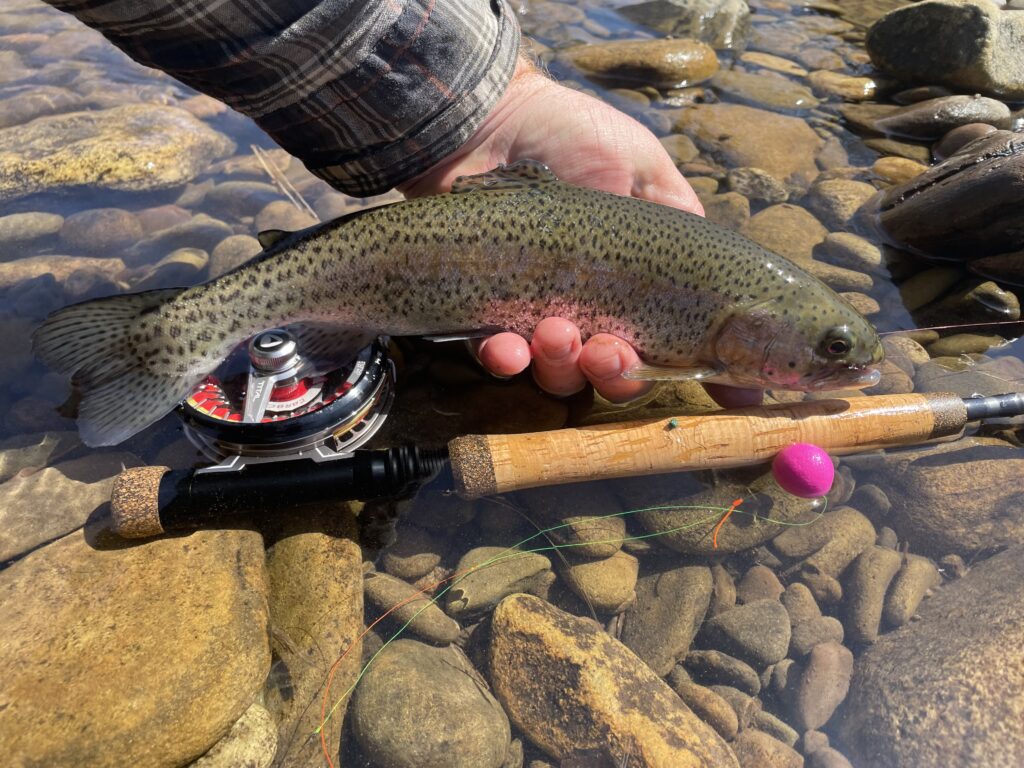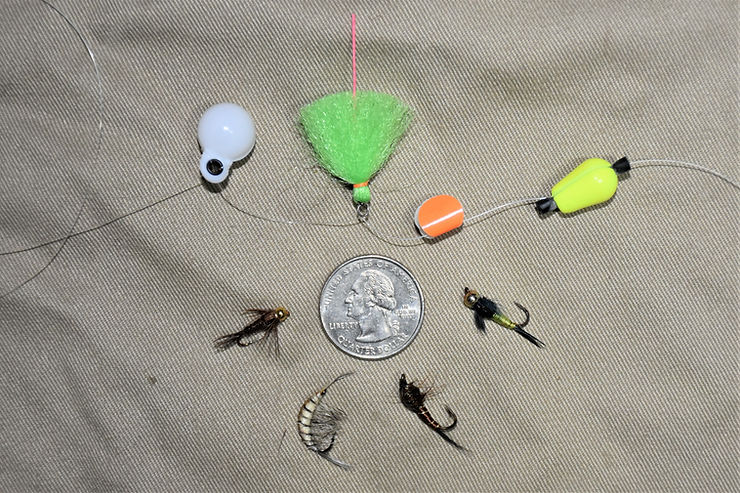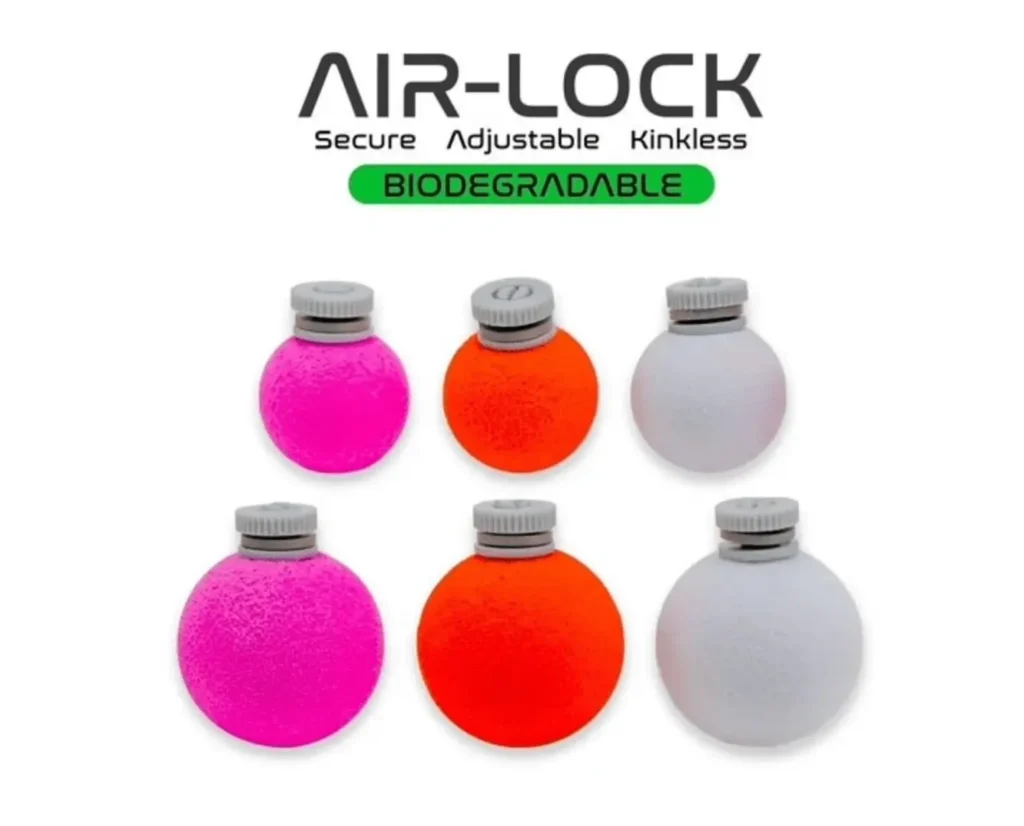Back to Basics: Indicator Nymphing

That was over 20 years ago, but that day was a landmark moment in my fly fishing career. I’d read about strike indicators prior to then, and like other critics, I’d brushed them off as “glorified bobbers.” I envisioned myself a fly fishing purist, after all, and the idea of putting a bobber on my fly line seemed blasphemous. Now, after realizing how effective they are for fishing nymphs, I gladly tie one on.
Selecting the Right Indicator for Nymphing

Strike indicators come in a wide variety of styles and colors. I opt for the smallest indicator I can get away with that will still support the nymph. If the weight or drag of the nymph is pulling the indicator underwater, bump up one indicator size.
Color can play a major role in how trout react, too. Although orange and pink are the most visible, white or off-white are usually better options. In nature, white objects often end up on the water – bird feathers, dandelion fibers, plant matter, etc. A white indicator appears no different than objects they see on a daily basis anyway.
A good gauge as to whether your indicator is working or detracting from your success is observing how fish react as it passes overhead. If they dart around the pool or even slash at the indicator, you know your indicator is drawing too much attention and you should switch to something more subtle.
The first strike indicators I ever used were plastic foam pads that had adhesive on one side and pinched onto your leader above the fly. They’re still a simple, easy-to-use product, but they have disadvantages. Once in position, they can’t be moved, and if you do decide to take them off, they usually leave a bit of sticky residue on the leader. That might not sound like a big deal, but throughout the course of a day, I fish a variety of water depths and current speeds, which requires a lot of adjustments. On an all-day excursion, I can burn through a lot of that style of indicator.
Another option would be to simply adjust your tippet length below the indicator, but again, this requires more time spent making adjustments and you can exhaust a spool of expensive tippet throughout the course of a day.
Nowadays, I prefer reusable strike indicators. Depending on the brand, a package of three usually costs about the same as a handful of quality dry flies, and some of them will last multiple seasons – or until they end up in a fly-grabbing tree. Here are a few brands of indicators available to fly anglers today and a few of their advantages and disadvantages.
Air-Locks – These are excellent indicators that can be very durable. I like the exterior post for attaching them onto the leader because I believe this makes strike detection more sensitive. When placed just above or below the junction of leader and tippet, the more supple tippet material will hang straight down, so you have a better connection to your nymphs. The major disadvantage of these indicators is the screw-on cap used to lock the line onto the exterior post. I’ve dropped literally dozens of these caps in the water and lost them, especially while fishing in cold weather when my fingers don’t always work as they should. Another disadvantage is that they can be hard to unscrew and hemostats are sometimes required to open them.
Many of the disadvantages of Air-Locks have been corrected with the upgraded Air-Lock “Centerlock” indicators. The Centerlocks have a design very similar to Oros, mentioned below, but have a very unique feature: a textured outer surface that makes adding and removing them much easier. These might be the best indicators on the market.
Thingamabobbers – These are solid indicators that work very well. Like the Air-Lock, they have an exterior attachment loop. What I don’t like about them is the metal ring inside that plastic loop. It doesn’t happen often, but occasionally a rough edge forms on that ring and I’ve had it slice the leader when setting the hook.
Tipper Strike Indicators – These are a good option but seem to wear out quicker than the other brands mentioned so far. The plastic post that slides into the foam body eventually loosens up from repeated adjustments over time. And again, much like the Air-Locks, you’re dealing with multiple pieces on the water, including a small black peg that can easily be dropped and lost.
Whitlock’s Telstrike Indicators – These are very good indicators for fishing over spooky trout. They land softly on the water, much like an oversized dry fly. The red “indicator” post that stands up in the middle can be hard to see from a distance, though. Also, they require treatment (and re-treatment) with a good floatant to keep them riding high all day.
Oros Indicators – Over the past couple of seasons, I’ve become very fond of Oros because they are perfectly round and the line is encapsulated within the indicator. Also, there are no small parts to contend with. Like Air-Locks, they can be difficult to open and sometimes require the use of hemostats to get a good grip to twist them open.
Poly Yarn and New Zealand Strike Indicators – Synthetic poly yarn or wool tied to the leader works as an inexpensive indicator, too. Simply use a small rubber band to attach the poly to the leader. The advantage of the synthetic poly yarn is that it can be colored and trimmed to fit the conditions. They’re also extremely sensitive and allow for a soft presentation. Bigger, bulkier indicators that land on the water with a plop can spook wary fish. As with the Telstrike Indicators, though, they typically require some sort of floatant to keep them riding high all day. Also, the small rubber bands can be difficult to handle at various times of year. A similar wool product is the New Zealeand Strike Indicator, which incorporates plastic tubing instead of the rubber band. The offer all the same advantages of homemade, poly yarn indicators but come in “kits” consisting of multiple colors.
Biostrike – This is a puddy-type, reusable compound used for making custom indicators on the water. That’s the main advantage of these; they can be made as small or as large as the situation requires. It’s also made of biodegradable material. The disadvantage of Biostrike is that it can be messy and take a little more time to make the adjustments you need to make.
Using a Dry Fly as an Indicator
The original strike indicators were attractor-style dry flies fished with droppers, and they’re still a good option today. Big, gaudy flies such as Stimulators, Humpies, and Royal Wulffs generally work well as an indicator. The added bonus is that you have another fly on the water that might spark a trout’s appetite, which gives you two chances to catch fish.
I’m particularly fond of foam-bodied flies, though, because they tend to be able to support heavier nymphs. Flies such as the Chubby Chernobyl are ideal and will float for longer periods of time without having to re-apply floatant. They’re also the most visible.
Dry-dropper rigs are ideal for fishing small streams and/or waters where fish spook easily. Later in the spring and early summer, for instance, when streams here in the Eastern U.S. start to drop and get very clear, I tend to use a large, bushy dry fly as an indicator rather than a brightly-colored piece of plastic or foam.
There are times, though, when casting a dry-dropper rig might not be ideal, such as when I’m fishing fast, deep water or fishing big nymphs for big trout. In both instances, I prefer a nymph tied straight to the leader or tippet because both can put a strain on your tackle, and fewer knots means fewer things that can go wrong. Also, I occasionally prefer to just fish nymphs and don’t want the extra hassle of tying to keep a dry fly floating. In those situations, I use one of the many varieties of strike indicators on the market.
Sometimes a manufactured strike indicator can spook fish on waters where trout see a lot of them. I equate it to highly-pressured whitetails that have a tendency to look up in an attempt to spot the silhouettes of hunters in treestands. Finicky trout can display the same traits, so you’ll need an indicator that accomplishes its purpose yet goes unnoticed.
Indicator Placement
Placement of the indicator on the leader can be a conundrum. You want enough distance between the indicator and nymph so that the nymph bounces along the bottom, yet the closer the indicator is to the nymph the better you’ll be able to detect strikes. Usually I settle on whatever the average depth of the pool or run happens to be. If my fly never bumps the bottom, or I don’t snag the bottom at least once in a while, I set it deeper.
The basic rule of thumb is that the distance between the indicator and the nymphs should be one and a half times the water depth. This is a very general rule, though, and greatly depends on water speed. In faster current, more length may be required in order to make sure the nymphs are riding close to the bottom. In slower water, a shorter distance is needed because the flies will hang straight down under the indicator.
When using traditional fly gear, I typically place the indicator on the leader, directly above the tippet ring used to connect the leader and tippet. (Hint: if you’re not using tippet rings, seriously consider giving them a try. They make line connections and adjustments on the water so much easier! Here’s an article that talks about the many advantages of using them.) This allows a tight line connection to the nymphs via the more supple tippet material rather than the stiffer leader.
I’m not afraid to employ an indicator while Euronymphing, too. Every discipline has its place and works best on certain water types, and Euronymphing is no different. It’s great for faster riffles and runs that are three feet deep or less. On deeper, slower moving water, or to reach prime lies beyond a couple rod lengths away, I attach an indicator to my mono rig. Again, I place it directly below the tippet ring to allow for more sensitivity between the flies and the indicator.
An advantage of fishing an indicator on the mono rig is that the long mono leader is much easier to keep up off the water with the typically longer Euro-style nymphing rods. You really can lead the indicator through the seam with a tight line connection to the indicator and get even better drag-free, natural drifts.

Importance of Mending the Line
The most important part of using an indicator, as with any style of nymphing, is getting a drag-free drift. The goal should always be to get a natural drift through the strike zone. This is accomplished with mending.
As soon as the indicator lands on the water, I like to do a big mend that moves all of my fly line upstream of the indicator. Ultimately, I want the indicator to lead the nymphs through the seam.
When the line gets downstream of the indicator, various currents begin to pull on the line and speed up the indicator. Here’s something incredibly important to keep in mind: whatever is happening to your indicator is also what’s happening to the nymphs below it. When the indicator moves, the nymphs move. When the indicator speeds up, the nymphs speed up, too.
The two main mistakes I see with folks learning to fish with indicators are these:
- They mend too late. Rather than mend right away, they wait until the fly line begins to drag/speed up the indicator, and so they end up mending when the indicator gets directly in front of them. When they do this, however, they’re moving their flies up out of the strike zone during the most important part of the drift. One big mend at the beginning of the drift will place all of the line upstream of the indicator so that the presentation will stay in the zone longer.
- They don’t know how to manage slack. As soon as the indicator hits the water, anglers have a tendency to pull up all of the slack so that the line is tight to the indicator. This can be good if using a high-sticking method where you’re holding all of the line up off the water to get a tight line connection to the indicator, but that’s not what most people do. Rather, all of the line stays on the water and they basically keep stripping in the slack as the indicator floats downstream. As a result, they’re pulling their presentation across multiple seams rather than allowing it to ride in a single seam.
Strike Detection
Detecting strikes can be challenging even when using an indicator. Trout are constantly in motion, sucking in and spitting out debris in a fraction of a second as they test its texture to determine whether or not it’s food. In the same manner, they can inhale and exhale a fly before the sensation even travels up the line to the indicator. Even once they take the fly, there’s always a slight delay before the action is transmitted up the line, so your reaction time is important. A quick hookset will land you more fish.
Strike indicators require complete concentration. If I see the slightest bit of hesitation or erratic movement with the indicator, I set the hook. Even if it’s a false alarm, and my indicator paused because my fly scraped the bottom, I’d rather set the hook and have nothing than not set the hook and miss a fish.
Last spring, I was guiding on a local stream and I saw a flash in the water about two feet below my client’s indicator. I told my client to set the hook. He questioned my instructions and the indicator continued to float downstream showing no signs of movement. Again, I told him to set and again he did not. Finally, near the tail end of the pool, he lifted the rod to make another cast…and the trout was still on there!
“I was staring at the indicator and had no idea a fish had hit,” he said. “How did you know?”
I explained that I saw the flash underneath. When fishing an indicator, my eyes aren’t necessarily trained on that brightly-colored object, but instead focused on what’s happening under it, and the indicator is in my peripheral.
Indicators take a lot of the guesswork out of strike detection. They’re one product that can almost immediately make you a better nympher. They’re more than just a bobber, and they can turn a frustrating outing of missing fish into a day of catching that you’ll never forget.






Hey Ralph. I don’t quite understand when to euro nymph versus when nymph with an indicator. Or, can I nymph with an indicator using my euro rig and/or flies? You do a great job explaining convoluted ideas. Like your latest article that categorized euro nymphs. So many light bulbs went off in my head as I read that!
Thanks man,
Bill
Hey Bill,
Thanks for reading and dropping a line! The way I look at it is that there are certain situations where indicator nymphing excels and situations where Euronymphing is best. In my opinion, indicator nymphing is a universal technique that can be used by anyone, anywhere, using almost any type of rig, even a Euronymphing rig. I often Euronymph particular sections where there are good riffles and runs, which are ideal for that technique, but when I get to larger, slower moving pools, I’ll pinch on an indicator above my flies. I still use Euro nymphs with the indicator, as I mentioned in the article you referenced that’s also on this site.
Euronymphing relies on maintaining constant contact with the stream bottom. That’s much easier to achieve in riffles and runs that are 2-3 feet deep, but more importantly, where there’s enough current to keep your flies moving at a steady pace. (Justin wrote a great article last summer that you may want to check out on this site: “Nymphing Approaches for a Specific Water Type.”) Generally speaking, Eurnonymphing is at its best when done in the specific water types he mentions in that article.
Larger, slow moving pools are more difficult to Euronymph because the flies simply sink to the bottom and you can’t get a natural drift because the current is just too slow. Also, because these pools are deeper, there’s more distance between your rod tip and the nymphs, which makes it a lot harder to detect strikes. In these situations, an indicator rig is superior because the indicator allows your flies to still dead-drift naturally near the bottom and helps you detect the strike a lot easier.
The advantage of indicators is that they’re not as complicated to fish. The real trick to using them is to get a drag-free drift so that the nymphs drift as naturally as possible and as close to the bottom as possible. So in Euronymphing, you’re fishing the nymphs (contact nymphing) but with indicator nymphing, you’re basically fishing the indicator, which allows you to fish the nymphs by default.
Hope this helps!
Ralph
very nice article. i’ve started using the smallest thingamabobber on my euronymphing rig when I’m not catching fish when I think I should be. the euro rig lets me be tight to the indy so that i’m getting as drag free a drift as I can. I attach the indy above my tippet ring (essentially onto my sighter material).